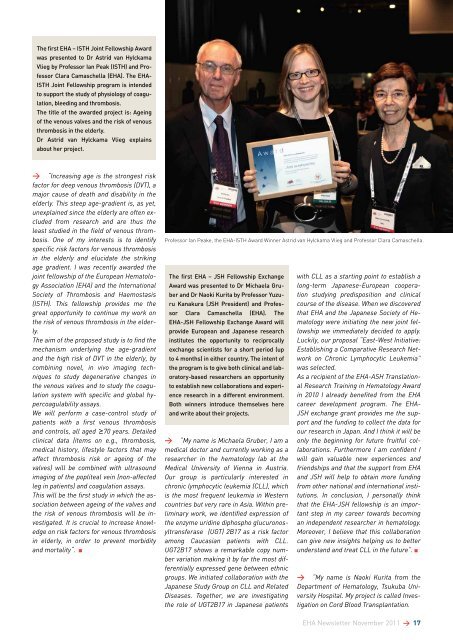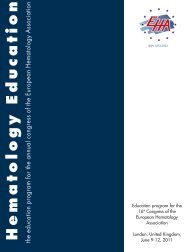Newsletter November 2011 - European Hematology Association
Newsletter November 2011 - European Hematology Association
Newsletter November 2011 - European Hematology Association
Create successful ePaper yourself
Turn your PDF publications into a flip-book with our unique Google optimized e-Paper software.
The first EHA – ISTH Joint Fellowship Award<br />
was presented to Dr Astrid van Hylckama<br />
Vlieg by Professor Ian Peak (ISTH) and Professor<br />
Clara Camaschella (EHA). The EHA-<br />
ISTH Joint Fellowship program is intended<br />
to support the study of physiology of coagulation,<br />
bleeding and thrombosis.<br />
The title of the awarded project is: Ageing<br />
of the venous valves and the risk of venous<br />
thrombosis in the elderly.<br />
Dr Astrid van Hylckama Vlieg explains<br />
about her project.<br />
> “Increasing age is the strongest risk<br />
factor for deep venous thrombosis (DVT), a<br />
major cause of death and disability in the<br />
elderly. This steep age-gradient is, as yet,<br />
unexplained since the elderly are often excluded<br />
from research and are thus the<br />
least studied in the field of venous thrombosis.<br />
One of my interests is to identify<br />
specific risk factors for venous thrombosis<br />
in the elderly and elucidate the striking<br />
age gradient. I was recently awarded the<br />
joint fellowship of the <strong>European</strong> <strong>Hematology</strong><br />
<strong>Association</strong> (EHA) and the International<br />
Society of Thrombosis and Haemostasis<br />
(ISTH). This fellowship provides me the<br />
great opportunity to continue my work on<br />
the risk of venous thrombosis in the elderly.<br />
The aim of the proposed study is to find the<br />
mechanism underlying the age-gradient<br />
and the high risk of DVT in the elderly, by<br />
combining novel, in vivo imaging techniques<br />
to study degenerative changes in<br />
the venous valves and to study the coagulation<br />
system with specific and global hypercoagulability<br />
assays.<br />
We will perform a case-control study of<br />
patients with a first venous thrombosis<br />
and controls, all aged ≥70 years. Detailed<br />
clinical data (items on e.g., thrombosis,<br />
medical history, lifestyle factors that may<br />
affect thrombosis risk or ageing of the<br />
valves) will be combined with ultrasound<br />
imaging of the popliteal vein (non-affected<br />
leg in patients) and coagulation assays.<br />
This will be the first study in which the association<br />
between ageing of the valves and<br />
the risk of venous thrombosis will be investigated.<br />
It is crucial to increase knowledge<br />
on risk factors for venous thrombosis<br />
in elderly, in order to prevent morbidity<br />
and mortality“.<br />
Professor Ian Peake, the EHA-ISTH Award Winner Astrid van Hylckama Vlieg and Professor Clara Camaschella.<br />
The first EHA – JSH Fellowship Exchange<br />
Award was presented to Dr Michaela Gruber<br />
and Dr Naoki Kurita by Professor Yuzuru<br />
Kanakura (JSH President) and Professor<br />
Clara Camaschella (EHA). The<br />
EHA-JSH Fellowship Exchange Award will<br />
provide <strong>European</strong> and Japanese research<br />
institutes the opportunity to reciprocally<br />
exchange scientists for a short period (up<br />
to 4 months) in either country. The intent of<br />
the program is to give both clinical and laboratory-based<br />
researchers an opportunity<br />
to establish new collaborations and experience<br />
research in a different environment.<br />
Both winners introduce themselves here<br />
and write about their projects.<br />
> “My name is Michaela Gruber, I am a<br />
medical doctor and currently working as a<br />
researcher in the hematology lab at the<br />
Medical University of Vienna in Austria.<br />
Our group is particularly interested in<br />
chronic lymphocytic leukemia (CLL), which<br />
is the most frequent leukemia in Western<br />
countries but very rare in Asia. Within preliminary<br />
work, we identified expression of<br />
the enzyme uridine diphospho glucuronosyltransferase<br />
(UGT) 2B17 as a risk factor<br />
among Caucasian patients with CLL.<br />
UGT2B17 shows a remarkable copy number<br />
variation making it by far the most differentially<br />
expressed gene between ethnic<br />
groups. We initiated collaboration with the<br />
Japanese Study Group on CLL and Related<br />
Diseases. Together, we are investigating<br />
the role of UGT2B17 in Japanese patients<br />
with CLL as a starting point to establish a<br />
long-term Japanese-<strong>European</strong> cooperation<br />
studying predisposition and clinical<br />
course of the disease. When we discovered<br />
that EHA and the Japanese Society of <strong>Hematology</strong><br />
were initiating the new joint fellowship<br />
we immediately decided to apply.<br />
Luckily, our proposal “East-West Initiative:<br />
Establishing a Comparative Research Network<br />
on Chronic Lymphocytic Leukemia”<br />
was selected.<br />
As a recipient of the EHA-ASH Translational<br />
Research Training in <strong>Hematology</strong> Award<br />
in 2010 I already benefited from the EHA<br />
career development program. The EHA-<br />
JSH exchange grant provides me the support<br />
and the funding to collect the data for<br />
our research in Japan. And I think it will be<br />
only the beginning for future fruitful collaborations.<br />
Furthermore I am confident I<br />
will gain valuable new experiences and<br />
friendships and that the support from EHA<br />
and JSH will help to obtain more funding<br />
from other national and international institutions.<br />
In conclusion, I personally think<br />
that the EHA-JSH fellowship is an important<br />
step in my career towards becoming<br />
an independent researcher in hematology.<br />
Moreover, I believe that this collaboration<br />
can give new insights helping us to better<br />
understand and treat CLL in the future”.<br />
> “My name is Naoki Kurita from the<br />
Department of <strong>Hematology</strong>, Tsukuba University<br />
Hospital. My project is called Investigation<br />
on Cord Blood Transplantation.<br />
EHA <strong>Newsletter</strong> <strong>November</strong> <strong>2011</strong> > 17












